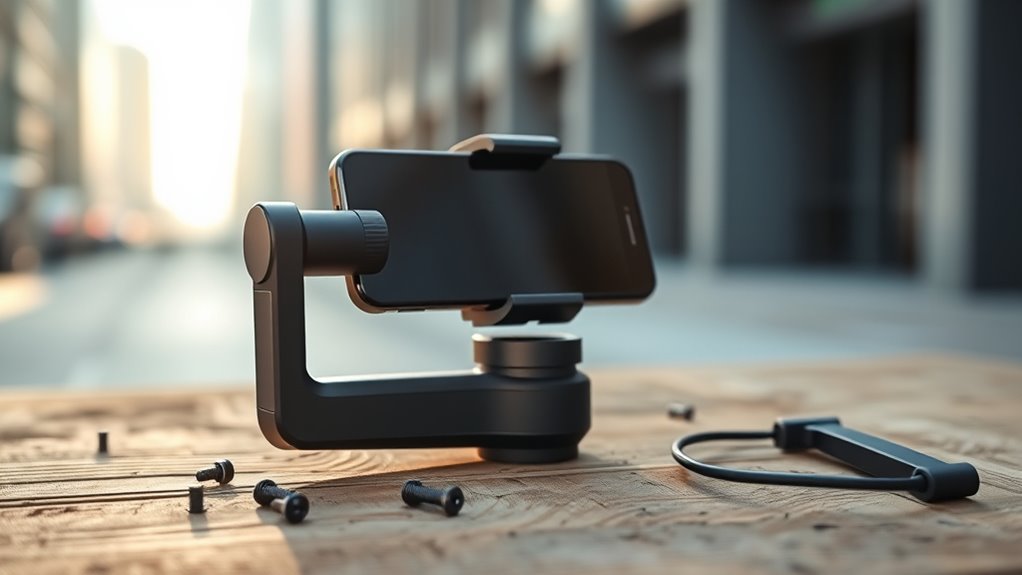If you’re looking for the top smartphone gimbals in 2025, I’ve got you covered. The DJI Osmo Mobile 7 offers excellent stabilization and easy portability, perfect for on-the-go shoots. The Hohem iSteady V3 combines AI tracking with remote control, making it great for dynamic shots. The DJI Osmo Mobile 6 is lightweight and packed with features like ActiveTrack 6.0. Keep going, and you’ll discover more details to help you choose the perfect device.
Key Takeaways
- Look for models with advanced 3-axis stabilization like DJI Osmo Mobile 7 and DJI Osmo Mobile 6 for smooth footage.
- Ensure compatibility with your smartphone’s size, weight, and OS (iOS/Android) for seamless operation.
- Prioritize gimbals offering long battery life (8-12 hours) and features like quick mode switching and creative shooting modes.
- Choose lightweight, foldable designs with ergonomic grips to enhance portability and ease of use during outdoor filming.
- Opt for models with dedicated apps supporting features such as AI tracking, Timelapse, and remote control for versatile shooting.
DJI Osmo Mobile 7 Gimbal Stabilizer for Smartphones

The DJI Osmo Mobile 7 stands out as the best choice for beginner and intermediate creators seeking professional-quality stabilization without the complexity. This lightweight, foldable gimbal is compatible with both iPhone and Android devices, making it versatile and easy to carry. It offers seamless 3-axis stabilization with DJI’s 7th-generation technology, ensuring smooth, cinematic footage. The built-in tripod and magnetic phone clamp simplify setup and storage. With features like ActiveTrack 7.0 for precise subject tracking and up to 10 hours of battery life, it’s perfect for capturing steady videos on the go. Plus, its user-friendly app makes editing quick and straightforward.
Best For: beginner and intermediate content creators seeking professional-quality smartphone stabilization with ease of use and portability.
Pros:
- Lightweight and foldable design for effortless portability and storage
- Seamless 3-axis stabilization with advanced ActiveTrack 7.0 for accurate subject tracking
- Up to 10 hours of battery life with the ability to charge smartphones during use
Cons:
- Compatibility limited to iPhone and Android smartphones; not suitable for larger devices
- Requires the DJI Mimo app, which may be removed from some app stores due to platform issues
- Slightly higher price point compared to basic gimbals without advanced tracking features
Hohem iSteady V3 Gimbal Stabilizer with AI Tracking and Remote
If you’re looking for a versatile gimbal that combines advanced AI tracking with easy remote control, the Hohem iSteady V3 is an excellent choice. It delivers ultra-smooth 3-axis stabilization with iSteady 8.0 technology, ensuring steady footage even during high-energy filming. Its extended roll arm lets you capture wide-angle shots without obstruction, and magnetic AI tracking keeps subjects in focus automatically, supporting face and body detection. The detachable remote offers precise control, whether used on its own or docked for charging. Plus, the built-in tripod and extendable rod add versatility for selfies, low-angle shots, or group footage, making it a well-rounded tool for creators.
Best For: content creators and vloggers seeking a portable, versatile gimbal with advanced AI tracking and remote control features for smooth, professional-looking footage.
Pros:
- Ultra-smooth 3-axis stabilization with iSteady 8.0 technology for steady footage during high-energy filming
- Magnetic AI tracking supports face and body detection for hands-free subject following
- Detachable remote control offers precise operation and can be used standalone or while charging
Cons:
- Slightly heavier compared to basic gimbals, which may affect extended handheld use
- Requires pairing with the Hohem Joy app for full creative features, adding a step for initial setup
- Limited availability of advanced modes without app integration, potentially restricting customization for some users
DJI Osmo Mobile 6 Gimbal Stabilizer for Smartphones

For anyone seeking effortless professional-quality videos on the go, the DJI Osmo Mobile 6 stands out with its advanced ActiveTrack 6.0 technology, which precisely follows moving subjects without help. It’s lightweight at just 10.8 ounces and folds easily for portability. The built-in extension rod adds creative angles and selfies, while the modern slate gray finish and ergonomic grip make it comfortable to handle. The gimbal quickly switches between horizontal and vertical modes with a double-click, and the Side Wheel allows precise focus and zoom control. Compatible with most smartphones, it’s perfect for vlogging, family moments, or capturing dynamic scenes effortlessly.
Best For: content creators, vloggers, and casual users seeking professional-quality stabilized videos with ease and portability.
Pros:
- Advanced ActiveTrack 6.0 technology for precise subject tracking without assistance
- Lightweight, foldable design weighing only 10.8 ounces for easy portability
- Built-in extension rod and intuitive controls for creative filming angles and quick mode switching
Cons:
- Compatibility may vary; users should verify their smartphone model before purchase
- DJI Mimo app is unavailable on Google Play and must be downloaded from DJI’s official website
- Limited to certain smartphone sizes and models, which may restrict some users
Factors to Consider When Choosing Smartphone Gimbals

When selecting a smartphone gimbal, I look at how well it works with my device and its stabilization power to keep shots smooth. I also consider battery life, portability, and smart features that make shooting easier. Knowing these factors helps me choose a gimbal that fits my needs perfectly.
Compatibility With Devices
Ever wondered how to guarantee your smartphone gimbal works perfectly with your device? First, check that the gimbal is compatible with your phone’s size and weight to assure a secure fit. If you switch between iOS and Android, look for a gimbal that supports both platforms and offers seamless connectivity. Verify the pairing options—Bluetooth or dedicated apps—and make sure they’re easy to use. Adjustable clamps or mounts are essential if your phone varies in size, so your device stays secure during filming. Finally, review the manufacturer’s compatibility list or recommended specs. Avoid pairing issues or performance hiccups by choosing a gimbal designed for your specific model. Proper compatibility guarantees smooth operation and ideal stabilization.
Stabilization Capabilities
The key to choosing a smartphone gimbal lies in its stabilization capabilities, which directly influence the quality of your footage. Effective stabilization guarantees smooth, jitter-free videos, even during dynamic movements. A good gimbal uses a 3-axis system to counteract pitch, roll, and yaw, keeping your shot steady regardless of hand or body motion. Advanced features like active stabilization algorithms can further reduce vibrations and unintended shifts, resulting in more professional-looking videos. This is especially important when filming fast-paced sports or outdoor scenes where stability is harder to maintain. Continuous improvements in stabilization technology aim to perform well in challenging conditions, such as windy environments or rapid directional changes, ensuring your footage remains steady and polished in any situation.
Battery Life Duration
Battery life plays a significant role in selecting a smartphone gimbal, as it determines how long I can film without interruption. Most models offer between 8 to 12 hours of operation on a single charge, which is usually enough for a full day of shooting. Extended battery life is especially important for capturing events or outdoor adventures where power sources may be scarce. Many gimbals also feature a USB-C port, allowing me to charge my smartphone directly through the gimbal, ensuring I stay powered during long shoots. Keep in mind, battery performance can vary depending on features like active tracking or motor settings. Recharging times and the availability of replaceable batteries are additional factors that help me maintain continuous filming sessions without delays.
Portability and Size
When selecting a smartphone gimbal, portability and size are crucial factors that can make a big difference in how easily I can carry and use the device. A lightweight gimbal, typically weighing between 300 grams and 15.8 ounces, is much more convenient for on-the-go filming. Compact, foldable designs allow me to fit the gimbal into small bags or even pockets, making travel and outdoor shoots effortless. Built-in tripods or extendable arms add stability and creative angles without adding bulk. Lightweight gimbals with ergonomic grips help reduce hand fatigue during long shoots, enhancing usability. Overall, size and foldability directly influence how easily I can store, transport, and quickly deploy the gimbal in various filming environments, especially when moving between multiple locations.
Intelligent Shooting Features
Choosing a smartphone gimbal with intelligent shooting features can substantially elevate your filmmaking experience. I look for models with advanced tracking technologies like ActiveTrack or AI-based face and body detection to keep subjects perfectly in focus. These features help me capture smooth, professional-looking footage without constantly adjusting the camera. I also value intelligent modes such as timelapse, panorama, slow motion, and Dolly Zoom, which expand creative possibilities. One-tap ShotGuides or preset modes simplify complex shots, making them accessible regardless of skill level. Seamless mode switching—like moving from horizontal to vertical orientation—is essential for versatile content creation. Additionally, compatibility with dedicated apps opens cinematic effects and intuitive controls, helping me achieve professional-quality results with ease.
Ease of Use
Ease of use is essential when selecting a smartphone gimbal, as it directly impacts how quickly and comfortably I can start filming. I look for models with intuitive controls and quick setup processes, so I don’t waste time figuring out how to operate them. Features like automatic tracking and mode switching make filming smoother by reducing manual adjustments. A lightweight, ergonomic design helps me handle the gimbal comfortably during long shoots. Compatibility with a dedicated app simplifies calibration, mode selection, and accessing features, saving me effort. Clear indicators, such as display panels or lights, are also helpful—they let me easily monitor battery life, modes, and system status without interrupting my workflow. Overall, a user-friendly design keeps me focused on capturing great footage.
Accessory Compatibility
Making sure your gimbal works seamlessly with your smartphone involves more than just fitting the device physically. You need to verify compatibility with your phone’s model, size, and weight limits to avoid issues during use. It’s also essential to check if the gimbal supports your operating system, whether iOS or Android, to ensure smooth app integration. Additionally, consider the availability of accessories like magnetic clamps or extension rods that are compatible with the gimbal, as these can expand your filming options. Don’t forget to confirm whether third-party accessories or modules are supported, which can enhance functionality. Finally, confirm the gimbal’s app or software is compatible with your device’s OS and offers the features you require, making your filming experience effortless and versatile.
App Integration Support
When selecting a smartphone gimbal, it’s essential to contemplate how well its dedicated app supports your creative needs. A good app should offer advanced features like tracking, Timelapse, and ShotGuides to give you more control over your shots. Make sure the app is regularly updated and compatible with your device’s operating system, whether iOS or Android. Seamless integration is vital for features like auto-tracking, focus control, and mode switching, which can considerably improve your filming experience. Additionally, look for remote control options, such as a detachable remote or smartwatch compatibility, to enhance versatility. Quick access to settings and presets also simplifies switching between different shooting modes, saving you time and effort during your shoots.
Frequently Asked Questions
How Do Smartphone Gimbals Improve Video Quality?
Smartphone gimbals improve video quality by stabilizing your shots, reducing shaky movements, and keeping the camera steady even when you’re on the move. They use motors to smooth out unwanted jitters, resulting in professional-looking footage. I find they make a huge difference, especially for dynamic scenes or outdoor filming, because they help me capture clear, smooth videos effortlessly. It’s like having a steady hand, no matter how much I move.
Are Gimbals Compatible With All Smartphone Models?
Most gimbals are compatible with a wide range of smartphone models, but I always double-check the mounting clamp size and weight limits before buying. Some gimbals come with adjustable clamps or universal mounts, making them versatile for various phones. If you’re using an especially large or small device, I recommend choosing a model with flexible compatibility options to guarantee a secure fit and best stabilization.
What Is the Typical Battery Life of These Gimbals?
You’ll love how long these gimbals last—most typically run between 8 to 12 hours on a single charge. It’s almost like they’re powered by magic, right? I’ve found that this means you can shoot all day without constantly hunting for a charger. Just imagine, capturing a full day’s adventures with steady shots and smooth videos, all thanks to a reliable battery life that keeps up with your creativity.
Can Gimbals Be Used for Live Streaming?
Absolutely, I use gimbals for live streaming all the time. They help keep my shots steady and professional-looking, even if I’m moving around. Most modern gimbals are compatible with live streaming apps and can connect via Bluetooth or Wi-Fi. Just make sure your gimbal supports your device and has the right controls. It’s a game-changer for smooth, high-quality streams that keep viewers engaged.
Do Gimbals Require Calibration Before Use?
Interestingly, I’ve found that most gimbals do require calibration before use. It’s like tuning a musical instrument—essential for smooth performance. I always calibrate my gimbal when I first set it up or if I notice shaky footage afterward. Calibration helps the gimbal understand your phone’s weight and balance, ensuring steady shots. So yes, a quick calibration is usually necessary to get the best, most stable videos.
Conclusion
Choosing the right smartphone gimbal is all about balancing stability, features, and ease of use. Whether you prioritize advanced AI tracking, seamless stabilization, or user-friendly design, there’s a perfect option for you. These top three models—DJI Osmo Mobile 7, Hohem iSteady V3, and DJI Osmo Mobile 6—each offer something unique. So, pick the one that best fits your needs, and start capturing smooth, professional-looking videos with confidence and clarity.









